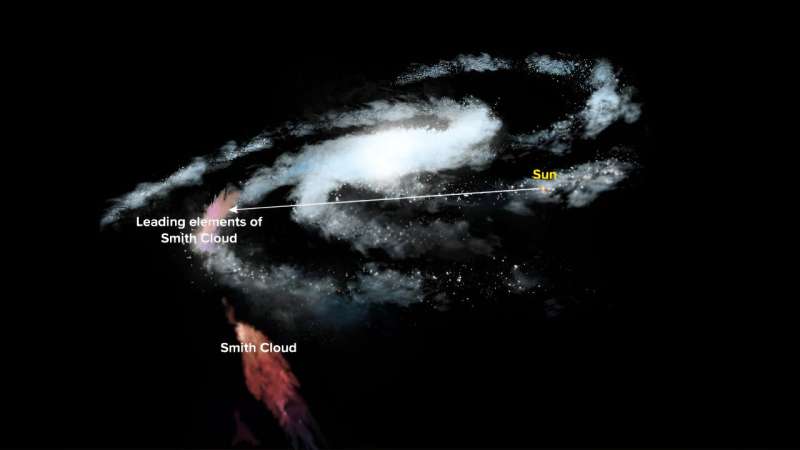This article has been reviewed according to Science X's editorial process and policies. Editors have highlighted the following attributes while ensuring the content's credibility:
fact-checked
proofread
While aiming for massive gas cloud, astronomers spot differences in thickness of Milky Way Galaxy

Space may appear vast and empty, but it's full of cosmological objects that are invisible to the human eye. From our vantage point on Earth, many of these objects fall between astronomers and what they hope to observe, impacting what they find. This scenario was recently encountered by scientists at the U.S. National Science Foundation's Green Bank Observatory (GBO), who were attempting to study the Smith Cloud, tucked away behind dense layers of gas and dust in our own Milky Way galaxy.
The Smith Cloud, containing enough gas to fill one million suns, is expected to crash into the Milky Way—in about 27 million years. Astronomers have been intrigued by this monstrous high velocity cloud since its discovery in the 1960s. GBO's Green Bank Telescope (GBT) and 20-meter telescope, along with NASA's Hubble Telescope, are the primary tools that have been used to study this massive and mysterious body of gas.
GBO scientist Toney Minter planned to observe the spot where part of the Smith Cloud is now interacting with the Milky Way. At this distance, and on the other side of the Milky Way, this observation is tricky, even for a telescope as sensitive as the GBT.
Minter was looking for dust and the faint emissions of hydroxl molecules (OH). The Smith Cloud should have very little to no dust and OH, while most clouds in the Milky Way contain both. If Minter found an area of accretion in the Milky Way where parts of the Smith Cloud had begun to mix, he would see the differences in their composition, and learn more about this interaction.
He says, "I knew there was a low probability that I'd find what I was looking for—and I didn't," laughs Minter, "But this is all part of the scientific process. You learn from what you DO and DON'T find."
Instead, Minter's observation revealed information about the structure of the inner part of our home galaxy. While looking through the Milky Way to search for OH molecules in his target area, Minter determined the thickness of the layer of molecules in the inner galaxy. This revealed the scale height of molecular gas in the inner Milky Way, measuring in around 100 parsecs, or 330 light-years across. Observations of molecules in the outer parts of the Milky Way are about 200 parsecs, or double the thickness.
What does this mean for what scientists know about the Milky Way? Minter adds, "All I can currently say is that the data we see from this part of the inner galaxy shows that it's different from the outer galaxy. We need more observations to learn more about what this means. That's why astronomy is exciting, our knowledge is always evolving."
Minter's initial findings will be shared at a press conference, Tuesday, June 11 at 10:15am CST at the 244th meeting of the American Astronomical Society June 9–13 in Madison, Wisconsin.
Provided by Green Bank Observatory




















